
Each vehicle is equipped with tyres designed to carry a maximum specifed load when operating at a maximum given speed. On the tyre’s sidewall there are various markings, which indicate the tyre’s dimensions and how it may be operated.
What does tyre size mean?
Tyre size indicates crucial specifications. The section width refers to the width of the tyre in millimeters, while the sidewall height is measured as a percentage of the section width. This height indicates the distance from the base of the tread to the rim. Additionally, the tyre size reflects the diameter of the wheel rim. Understanding these components empowers you to select tyres suitable for your vehicle, considering factors like grip, ride comfort, and aesthetics.

Principle markings are:
1. Brand name
2. Model name
3. Section width (mm)
4. Aspect ratio
5. Radial construction
6. Rim diameter
7. Service description - Load & Speed ratings
Tyre Size Markings
Section Width: The tyre’s section width is measured on an ideal width of wheel, for which it has been designed to operate. The measurement distance in millimeters is from the maximum width of the tyre’s mid point of its sidewall to the same point on the opposite sidewall.
Aspect Ratio*: This is the height of the tyre’s sidewall expressed as a percentage of the tyre’s section width. In the example, the height of the tyre’s sidewall is 40% of the tyre’s section width or 245 x 40% = 98mm.
* see below.
Construction Code: R indicates the tyre is manufactured with a radial ply construction.
Rim Diameter: The tyre’s rim diameter is measured in inches taken from the wheel flange where the tyre is seated (bead seat area) to the same point on the opposite side.
Load Index: The load rating, load index or load carrying capacity is represented by a numerical code and is associated with the maximum load that the tyre can carry when operating at its maximum speed rating up to but not exceeding 210kph.
Click here for more details
Speed Index: The speed rating or speed index is represented by a letter and associated with the tyre’s maximum speed capability when operating at its maximum load carrying capacity. A tyre marked with a ‘Y’ speed rating, indicates it can be safely operated at a maximum speed of 300kph. Click here for more details
Other Tyre Marking examples:
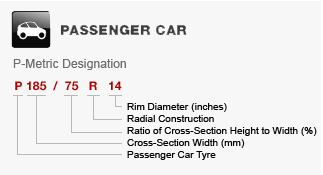
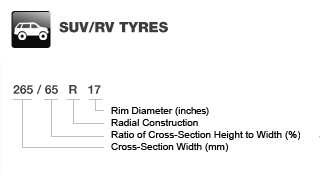
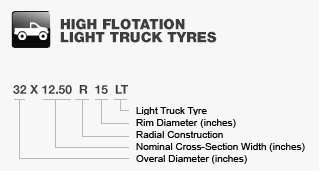
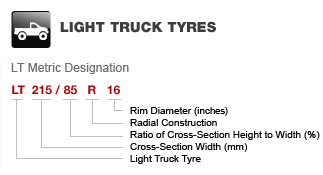
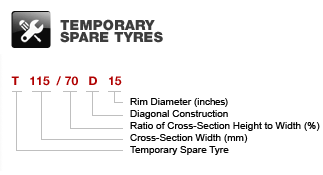
Understanding Tyre Aspect Ratio: Definition and Calculation
Tyre aspect ratio refers to the percentage representation of a tyre's height off the rim compared to its width. This ratio is calculated by dividing the tyre's height by its width and expressing it as a percentage. For instance, an aspect ratio of 70 indicates that the tyre's height is 70% of its width. Understanding aspect ratio is crucial as it affects the overall dimensions and performance characteristics of a tyre. By considering aspect ratio, you can make informed decisions when choosing tyres that suit your driving needs and preferences.
Many people mistake the tyre section width, with the tread width.
The width of the tyre section measured in millimetres (mm) is the widest point from sidewall to sidewall, so a higher number indicates a wider tyre. For example, in a tyre code P225/50R16 92V, the section width would be 225mm.
On the other hand, the tread width is the measurement between the outboard and inboard edges of a new tyre tread design. This is roughly the width of the tread that comes into contact with the road. However, the tread width can vary among manufacturers and models, even when it has the same tyre width. You can usually find your tyre specifications in your manual.
The aspect ratio is an important sizing calculation in tyre fitting. Different aspect ratios change the way tyres respond to the road and affect their cornering and traction capabilities.
A higher aspect ratio (higher sidewall) causes the tyre to flex and absorb the shocks, providing a more cushioned ride. On the downside, this flex can also decrease your handling ability when cornering.
A lower aspect ratio (smaller sidewall) produces a bumpier, less comfortable ride as the tyres hold less air leading to more vibrations through the vehicle. However, the lower the aspect ratio, the less flex giving you better steering capacity and better handling.
Also, a low-profile tyre typically has more contact with the road, which creates a firmer footprint that provides improved cornering and traction.
Using a different aspect ratio will change the way your tyres respond to the road and will affect how much power is needed to turn. It can cause alignment issues, unnecessary stress on the powertrains, and lead to a dip in fuel economy.
That said, there are many different sizes and types of tyres for modern-day vehicles, and the standard manufacturer tyre may not be best suited for your individual needs. A good rule of thumb is to only change the aspect ratio or the tyre width and never the diameter. By doing so, you can ensure the tyre ratio remains around the same to keep your tyre driving the way manufacturers designed it to be.
You can use a tyre size calculator online to help you. The calculator will figure out the diameter of the rims and match it against the overall diameter to determine whether that specific size will work for your particular vehicle type and model.
Still unsure what tyre would suit your needs?
Chat to your local, friendly JAX representative to find the best tyre for you.
There are two main types of tyre construction - cross-ply and radial.
Tyre Construction: Cross-Ply
Cross-ply refers to how nylon cords are constructed to cross over each other diagonally. These are layered over each other at a 45-degree angle before they’re encased in a toughened rubber outer shell. These thick rubber piles provide tough, rigid sidewalls.
Cross-ply tyres are thought to provide higher resistance against sidewall damage. They also have a higher rolling resistance which causes them to heat up quickly, increasing the air pressure within the tyres.
Tyre Construction: Radial
The radial tyre was produced after the cross-ply design to be a more flexible tyre. Manufacturers constructed the radial tyre from steel cords that have been rubber bonded and placed at a wider angle of 90 degrees. The addition of steel belts supports the tread areas of a tyre. These run across the circumference of the tyre.
Without a stiff sidewall, the radial tyre construction can absorb vibrations and shocks better, leading to a more comfortable ride. Also, less heat and noise are generated with less steel cords suspended within the rubber, which further increases comfort and decreases ‘blow-out punctures’ due to overheating.
The wheel rim diameter, measured in inches, is the diameter of the rim from one edge of the tyre that sits on the wheel (the bead seat) to the other.
You can find the tyre size in three different places: molded on its sidewall, the vehicle manual and the tyre placard. You can find the tyre rim diameter within the tyre size code. For example, with the tyre code P225/50R16 92V, the rim diameter would be 16 inches.
The load index is the maximum load capacity (kgs) that each tyre can carry. We usually consider the load index in combination with the tyre's speed index. Often, tyres with a higher load index number can carry heavier loads than those with a lower number.
The load index is crucial to the safety of yourself and your passengers. Subjecting your vehicle's tyres to weights that they’re not designed for will increase stress and excessive heat that will eventually build up and compromise the tyre's integrity. Compromising the tyres this way can have potentially catastrophic results.
If you're unsure, first check your load index, which you can find in your tyre code located on your tyre sidewall or in your owner's manual. For example, with the tyre code P225/50R16 92V, the load capacity would be 92V indicating the load index. You can use this conversion table to tell you what each load rating number means, and in this case, the 92 shows that the tyre's load is 630kgs.

